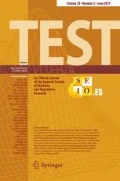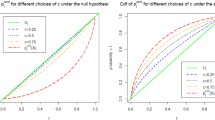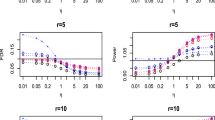Abstract
In many existing methods of multiple comparison, one starts with either Fisher’s p value or the local fdr. One commonly used p value, defined as the tail probability exceeding the observed test statistic under the null distribution, fails to use information from the distribution under the alternative hypothesis. The targeted region of signals could be wrong when the likelihood ratio is not monotone. The oracle local fdr based approaches could be optimal because they use the probability density functions of the test statistic under both the null and alternative hypotheses. However, the data-driven version could be problematic because of the difficulty and challenge of probability density function estimation. In this paper, we propose a new method, Cdf and Local fdr Assisted multiple Testing method (CLAT), which is optimal for cases when the p value based methods are optimal and for some other cases when p value based methods are not. Additionally, CLAT only relies on the empirical distribution function which quickly converges to the oracle one. Both the simulations and real data analysis demonstrate the superior performance of the CLAT method. Furthermore, the computation is instantaneous based on a novel algorithm and is scalable to large data sets.










Similar content being viewed by others
References
Benjamini Y, Hochberg Y (1995) Controlling the false discovery rate: a practical and powerful approach to multiple testing. J R Stat Soc Ser B 57(1):289–300
Cao H, Sun W, Kosorok MR (2013) The optimal power puzzle: scrutiny of the monotone likelihood ratio assumption in multiple testing. Biometrika 100(2):495–502
Choe SE, Bouttros M, Michelson AM, Chruch GM, Halfon M (2005) Preferred analysis methods for affymetrix genechips revealed by a wholly defined control dataset. Genome Biol 6(2):1–16
Dvoretzky A, Kiefer J, Wolfowitz J (1956) Asymptotic minimax character of the sample distribution function and of the classical multinomial estimator. Ann Math Stat 27(3):642–669
Efron B (2008) Microarrays, empirical Bayes and the two-groups model. Stat Sci 23(1):1–22
Efron B (2010) Large-scale inference: empirical Bayes methods for estimation, testing, and prediction, vol 1. Cambridge University Press, Cambridge
Efron B, Tibshirani R, Storey JD, Tusher V (2001) Empirical Bayes analysis of a microarray experiment. J Am Stat Assoc 96(456):1151–1160
Fisher RA (1925) Statistical methods for research workers. Oliver and Boyd, Edinburgh
Fisher RA (1935) The design of experiments. Oliver and Boyd, Edinburgh
Fisher RA (1959) Statistical methods and scientific inference. Oliver and Boyd, Edinburgh
Genovese C, Wasserman L (2002) Operating characteristics and extensions of the false discovery rate procedure. J R Stat Soc Ser B 64(3):499–517
He L, Sarkar SK, Zhao Z (2015) Capturing the severity of type II errors in high-dimensional multiple testing. J Multivar Anal 142:106–116
Hwang JT, Qiu J, Zhao Z (2009) Empirical Bayes confidence intervals shrinking both means and variances. J R Stat Soc Ser B 71(1):265–285
Karlin S, Rubin H (1956a) Distributions possessing a monotone likelihood ratio. J Am Stat Assoc 51:637–643
Karlin S, Rubin H (1956b) The theory of decision procedures for distributions with monotone likelihood ratio. Ann Math Stat 27(2):272–299
Liu Y, Sarkar SK, Zhao Z (2016) A new approach to multiple testing of grouped hypotheses. J Stat Plan Inference 179:1–14
Neyman J, Pearson ES (1928a) On the use and interpretation of certain test criteria for purposes of statistical inference: part I. Biometrika 20(1/2):175–240
Neyman J, Pearson ES (1928b) On the use and interpretation of certain test criteria for purposes of statistical inference: part II. Biometrika 20(3/4):263–294
Neyman J, Pearson ES (1933) On the problem of the most efficient tests of statistical hypotheses. Philos Trans R Soc Lond Ser A Contain Pap Math Phys Charact 231:289–337
Pearson RD (2008) A comprehensive re-analysis of the Golden Spike data: towards a benchmark for differential expression methods. BMC Bioinform 9(1):164
Sarkar SK, Zhou T, Ghosh D (2008) A general decision theoretic formulation of procedures controlling FDR and FNR from a Bayesian perspective. Stat Sin 18(3):925–945
Sun W, Cai TT (2007) Oracle and adaptive compound decision rules for false discovery rate control. J Am Stat Assoc 102(479):901–912
Sun W, Cai TT (2009) Large-scale multiple testing under dependence. J R Stat Soc Ser B 71(2):393–424
Zhang C, Fan J, Yu T (2011) Multiple testing via FDRL for large-scale imaging data. Ann Stat 39(1):613–642
Acknowledgements
This research is supported in part by NSF Grant DMS-1208735 and NSF Grant IIS-1633283. The author is grateful for initial discussions and helpful comments from Dr. Jiashun Jin.
Author information
Authors and Affiliations
Corresponding author
Additional information
Publisher's Note
Springer Nature remains neutral with regard to jurisdictional claims in published maps and institutional affiliations.
Appendix
Appendix
1.1 Proof of Theorem 1
(a) Theorem 2.2 and its proof in He et al. (2015), the optimal rejection set \(\mathbb {S}_F(q)\) is given as
where c is chosen as the minimum value such that mfdr is less than or equal to q.
When \(\varLambda \) is monotone increasing, then \(\mathbb {S}_F(q) = (c', \infty )\). This agrees with the \(\mathbb {I}_{BH}(q)\) and \(\mathbb {I}_F(q)\) defined in Eq. (8).
(b) When \(\mathbb {S}_F(q)\) is a finite interval, by the definition, \(\mathbb {I}_F(q) = \mathbb {S}_F(q)\). Since the right end point of the interval \(\mathbb {I}_F(q)\) is \(\infty \), it is not optimal. \(\square \)
1.2 Proof of Theorem 2
For any interval \(\mathbb {I}_i=[a,b]\), let \(s(a,b)=(1-\pi _1)\int _a^b\hbox {d}F_0(x)-q\int _a^b\hbox {d}F(x)\). Then
Consequently, for any fixed a, s(a, b) is increasing with respect to b. Since \(s(a, a)=0\), therefore, \(s(a, b)>0, \forall b>a\). This implies that \((1-\pi _1)\int _{\mathbb {I}_i}\hbox {d}F_0(x)> q\int _{\mathbb {I}_i}\hbox {d}F(x)\), for all \(i=1,2,\ldots \). As a result,
which completes the proof. \(\square \)
1.3 Proof of Theorem 3
Let \(s(a,b)=(1-\pi _1)\int _a^b \hbox {d}F_0(x) - q\int _a^b \hbox {d}F(x)\). Consider \(a=c_1\). Then \(s(c_1,c_1)=0\). According to the proof of Theorem 2, \(\frac{\partial s}{\partial b}<0, \forall b\in [c_1,c_2]\). This implies that \(s(c_1,c_2)<0\) and consequently \([c_1,c_2]\subset \mathbb {S}_F(q)\). \(\square \)
1.4 Proof of Theorem 4
Define the function \(s(a)=(1-\pi _1) \int _a^\infty \hbox {d}F_0(x) - q\int _a^\infty \hbox {d}F(x)\). Then
Let c be the value such that \(\varLambda (c)=q'\). When \(a\ge c\), \(s'(a)>0\), implying that s(a) is increasing with respect to a. Since \(s(\infty )=0\), therefore \(s(c)<0\). Consequently, \(\mathbb {I}_{F}(q)\) contains \([c,\infty )\). \(\square \)
1.5 Proof of Theorem 5
According to the definition of s(a, b) and \(c_1, c_2\), we know that
Consequently, for any fixed a, s(a, b) increases when \(b<c_1\) or \(b>c_2\) and decreases when \(c_1<b<c_2\). Similarly,
For any fixed b, s(a, b) decreases when \(a<c_1\) or \(a>c_2\) and inreases when \(c_1<a<c_2\). To demonstrate this pattern, we plot various curves of s(a, b) in Fig. 11.
Since g(a) attains the maximum at \(a_0\), according to Theorem 3, \(a_0<c_1\) and \(b_{a_0}(F)>c_2\). Consequently, \((1-\pi _1)f_0(a_0)-qF'(a_0)>0\), and \((1-\pi _1)f_0(b_{a_0}(F))-qF'(b_{a_0}(F))>0\). Therefore, the function \(b_a(F)\) is a monotone increasing function of a at a small neighborhood of \(a_0\). For a sufficiently small constant L independent of n, there exists a neighborhood \(A'\) of \(b_{a_0}(F)\) such that \(f_0(x)-qF'(x)>L\), \(\forall x\in A'\cup b^{-1}_{A'}(F)\) where \(b^{-1}_{A'}(F)=\{a: b_a(F)\in A'\}\). Let \(A=[a_1,a_2]=b^{-1}_{A'}(F)\) where \(a_1<a_0<a_2<c_1\). The proof of Theorem 5 requires the following lemmas.
Lemma 1
Let \(F_n\) be the empirical distribution function, then \(\forall a\), if \(b_a(F)=+\infty \) or \(b_a(F)<+\infty \) and \(F'(b_a(F))-\frac{1}{q}f_0(b_a(F))\ne 0\), then
If \(F'(b_a(F))-\frac{1}{q}f_0(b_a(F))=0\), then \(\limsup g_n(a)\le g(a)\).
Lemma 2
There exists a sub-interval \(\mathbb {B}=[b_1,b_2]\) of \(\mathbb {A}=[a_1,a_2]\), such that for all \(a\in \mathbb {B}\), \(|b_a(F_n)-b_a(F)|\le C\epsilon \) provided that \(||F_n-F||<\epsilon \).
Lemma 3
The function \(g_n(a)\) can not achieve the maximum at \(\mathbb {B}^c\).
Lemma 4
For any \(a\in \mathbb {B}\), \(|g_n(a)-g(a)|<C\epsilon \).
Proof of Theorem 5
Assume that \(g_n(a)\) attains the maximum at \(a=a_n\), then according to Lemma 3, \(a_n\in \mathbb {B}\). According to Lemma 4,
Since \(g(a_n)-g(a_0)<0\), \(g_n(a_n)-g(a_0)=g_n(a_n)-g(a_n)+g(a_n)-g(a_0) <C\epsilon \). In other words, \( |g_n(a_n)-g(a_0)|<C\epsilon . \) Further, DKW’s inequality guarantees that \(P(\sup _x|F_n(x)-F(x)|>\epsilon )\le 2e^{-2n\epsilon ^2}\). Consequently,
Next, we will prove that \(\limsup _{n\rightarrow \infty } m\textsc {fdr}\le q\). According to the definition of \(a_n\),
The mfdr can be written as
Note that \(|g_n(a_n)-g(a_n)|\le |g_n(a_n)-g(a_0)|+|g(a_n)-g(a_0)|\rightarrow 0\) and \(g(a_n)\rightarrow g(a_0)>0\). Consequently,
\(\square \)
Proof of Lemma 1
Since \(F_n\) is the empirical cdf, DKW’s inequality guarantees that \(\forall \epsilon >0\), with high probability \( F(x)-\epsilon \le F_n \le F(x)+\epsilon ,\forall x. \) Consider the function
Then by the definition of \(b_a(F_n)\) and \(F_U\),
Consequently, \(b_a(F_n)\le b_a(F_U)\). Similarly define
Then one can similarly show that \(b_a(F_L)\le b_a(F_n)\). As a result, \( b_a(F_L)\le b_a(F_n)\le b_a(F_U). \) If \((1-\pi _1)f_0(b_a(F))-qF'(b_a(F))\ne 0\) and \(b_a(F)<\infty \), then the curve s(a, b) is strictly increasing at a neighbourhood of \(b_a(F)\). Consequently, there exists a neighbourhood N of \(b_a(F)\) such that \(b_a(F_U)\) and \(b_a(F_L)\) fall in this neighbourhood N. Consequently, \( b_a(F_n)\rightarrow b_a(F). \) If \(b_a(F)=+\infty \), then \(b_a(F_L)\rightarrow \infty \), implying \(b_a(F_n)\rightarrow b_a(F)\). Furthermore,
If \((1-\pi _1)f_0(b_a(F))-qF'(b_a(F))=0\), then there exists an neighborhood C of \(b_a(F)\) such that \(s(a,x)>\delta > 0, \forall x\in C^c\cap [b_a(F), +\infty )\). Then \(b_a(F_n)\) is bounded by \(b_a(F_U)\) which converges to \(b_a(F)\). Consequently,
\(\square \)
Proof of Lemma 2
Let \(\mathbb {B}=[b_1,b_2]\) be a sub-interval of \(\mathbb {A}=[a_1,a_2]\) that contains \(a_0\) such that \(b_{\mathbb {B}}(F)\subset b_{\mathbb {A}}(F)\). For any \(a\in \mathbb {B}\), let \(\varDelta = s(a, b_{a_2}(F)) >0\). Since \(s(a, b_{a_2}(F))\) is a continuous function of a and \(\mathbb {B}\) is a closed interval, one can find a common lower bound \(\varDelta \) such that \(s(a, b_{a_2}(F))>\varDelta , \forall a\in \mathbb {B}\). Since \(\frac{\partial s(a, t)}{\partial t}>0\), \(\forall t>b_{a_2}(F)\), \(s(a, t)>\varDelta \) for all \(a\in \mathbb {B}\) and \(t>b_{a_2}(F)\). The definition of \(b_a(F_n)\) indicates that
This leads to
Therefore \(b_a(F_n)<b_{a_2}(F)\).
Next, we will show that \(b_a(F_n)> b_{a_1}(F)\). According to the definition of \(b_a(F)\), \(s(a, b_a(F))=0\) and
We can find \(t_0<b_a(F), t_0 > b_{a_1}(F)\), such that
Therefore for sufficiently small \(\epsilon \),
which implies that \(b_a(F_n)>t_0> b_{a_1}(F)\). Consequently, \(b_a(F_n)\in b_A(F)\).
Next, we will prove that \( |b_a(F_n)-b_a(F)|\le L\epsilon . \) Indeed, since \((1-\pi _1)(F_0(b_a(F_n))-F_0(a))-q(F_n(b_a(F_n))-F_n(a))\le 0\) and
then
As a result,
By the definition of \(b_a(F_n)\), \((1-\pi _1)(F_0(b_a(F_n)^+) - F_0(a))-q(F_n( b_a(F_n)^+) - F_n(a))>0\). With (14), we know that
When we take the limit in the previous formula and combine it with (15), we see that
Therefore
Since \(b_a(F), b_a(F_n)\in b_{\mathbb {A}}(F)\), \(|qF'(\xi )-f_0(\xi )|>L\), we conclude that \(|b_a(F_n)-b_a(F)|\le C\epsilon \) for some constant C. \(\square \)
Proof of Lemma 3
Firstly, we will show that there exists a positive constant \(\varDelta \) such that \(g(a_1)-g(a_0)<-\varDelta \), \(\forall a_1\notin \mathbb {B}\).
Since
and \(s(a,c_2)\) decreases when \(a<c_2\) and increases when \(c_1<a<c_2\). Combining this with the fact that \(s(c_2,c_2)=0\), one knows that there exists a unique \(a^*<c_1\) such that \(s(a^*,c_2)=0\). Let \(\mathbb {I}=\{[a,b]: s(a,b)\le 0\}\) and
First, we prove that \(\mathbb {L}=[a^*,c_2)\). Indeed if \(a'>c_2\), then for any \(b>a'>c_2\), \( s(a',b)>s(a',a')=0. \) Iff \(a'<a^*<c_1\), then \(s(a',b)>s(a^*,b)\ge 0, \forall b>a^*\). Consequently \(\mathbb {L}\subset [a^*,c_2)\). On the other hand, for any \(a^*\le a \le c_2\), \(s(a,c_2)\le s(a^*,c_2)=0\), implying that \([a^*, c_2)\subset \mathbb {L}\). Consequently, \(\mathbb {L}=[a^*,c_2)\).
Note that when \(c_1<a\le c_2\), \(g(a)<g(c_1)\). We thus only need to consider \(\mathbb {L}'=[a^*,c_1]\). The function \(g: \mathbb {L}'\rightarrow [0,1]\) is a continuous function and g(a) attains the maximal at a unique point \(a=a_0\). Therefore, we can find a positive constant \(\varDelta \) such that
For any \(a_1\in B^c\), if \(a_1\) satisfies \(f_0(b_{a_1}(F))-qF'(b_{a_1}(F))=0\), Lemma 1 implies that \(\limsup _{n\rightarrow \infty } g_n(a_1)\le g(a_1)<g(a_0)-\varDelta \). The fact that \(g_n(a_0)\rightarrow g(a_0)\) implies that \(g_n(a_1)<g_n(a_0)\) for sufficiently large n.
If \((1-\pi _1)f_0(b_{a_1}(F))- qF'(b_{a_1}(F))\ne 0\), then
According to Lemma 1, \(g_n(a_1)\rightarrow g(a_1), g_n(a_0)\rightarrow g(a)\), then \(g_n(a_1)<g_n(a_0)\). Consequently, \(g_n\) attains the maximum in \(\mathbb {B}\). \(\square \)
Proof of Lemma 4
According to Lemma 2, \(b_a(F_n)-b_a(F)=O(\epsilon )\), consequently, \( |g_n(a)-g(a)|\le C\epsilon . \) \(\square \)
1.6 EM algorithm
In this section, we outline the steps of EM algorithm. Let \(X_1,X_2,\ldots ,X_n\) be the test statistic. We fit the following model
The parameters to be estimated are \(\pi _1\), \(p_l\), \(\mu _l\), and \(\sigma _l^2\), for \(l=1,2,\ldots , L\).

Rights and permissions
About this article
Cite this article
Zhao, Z. Where to find needles in a haystack?. TEST 31, 148–174 (2022). https://doi.org/10.1007/s11749-021-00775-x
Received:
Accepted:
Published:
Issue Date:
DOI: https://doi.org/10.1007/s11749-021-00775-x





